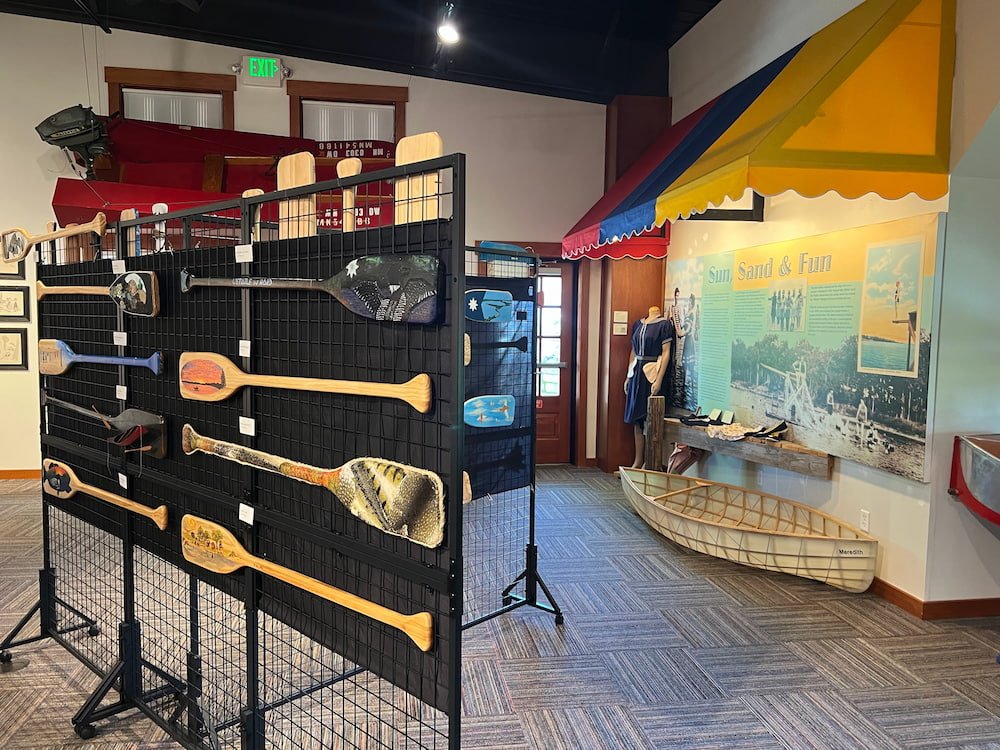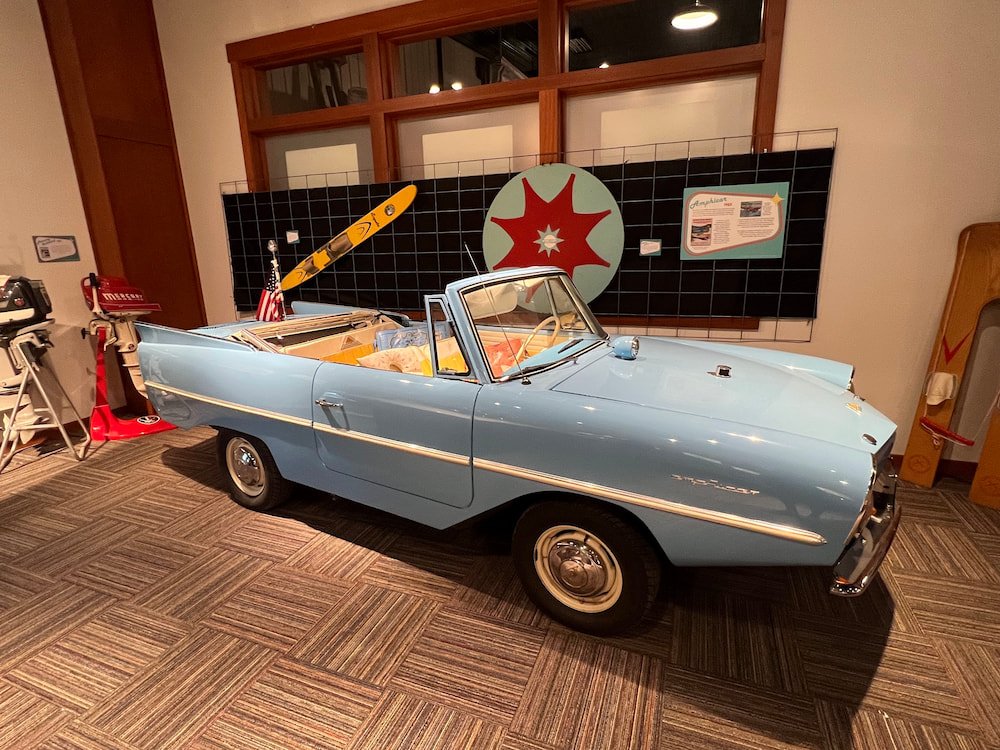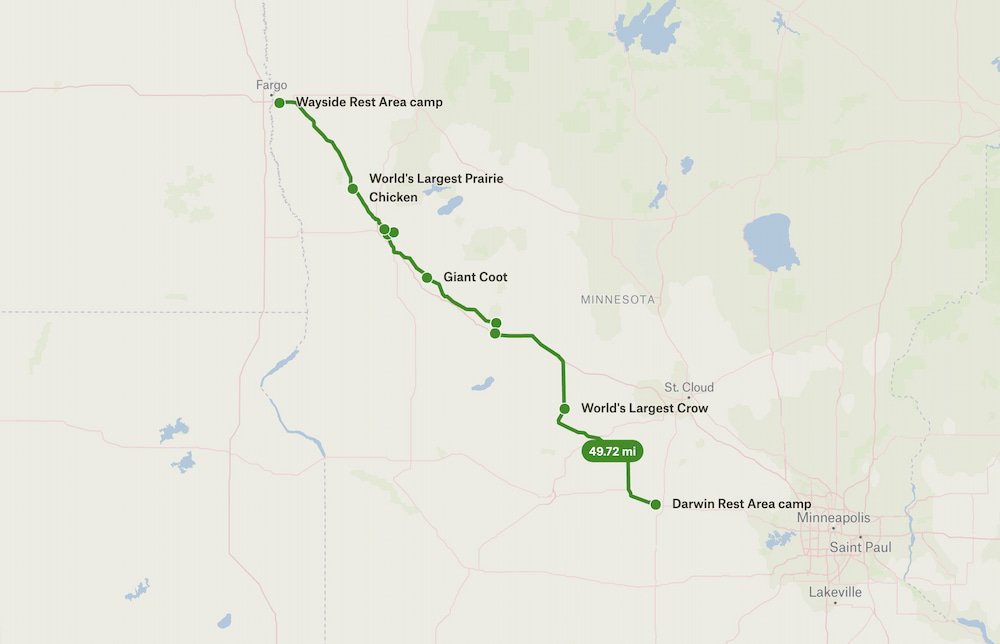South Dakota may be love its sculptures, but if it's BIG sculptures you want, then Minnesota was the place to visit. We're not sure why Minnesota has so many giant, "world's largest" sculptures, but these roadside stops remind us of Australia, where we have the Big Merino, Big Banana, Big Lobster, and many more!
The World's Largest Prairie Chicken
We didn't go to all of Minnesota's big sculptures, because there were so many, but our first one was the World's Largest Prairie Chicken, which stands at almost 4 meters (13 feet) and is almost 5.5 meters long (18 feet), and weighs a whopping 4,000 kilograms (9,000 pounds). It was built to celebrate the town of Rothsay's self-declared title as the "Prairie Chicken Capital" as these birds once were abundant on the prairies but nearly vanished by the 1930s due to hunting and habitat loss.

The Largest Mental Health Hospital in Minnesota
Next up, we stopped briefly at the Fergus Falls State Hospital. It opened in 1890 as a mental institution, becoming the largest mental health hospital in the state by the late 1920s, housing over 1,700 patients. It quickly became overcrowded, with many patients staying there for life. While drug therapy meant that patient care evolved and the hospital's mission changed, the Fergus Falls Regional Treatment Center, which is what it was last called, closed in 2005. Today, the buildings are dilapidated and boarded up in parts. There have been suggestions to renovate or redevelop the buildings, but it's extremely costly, so most of the buildings lie vacant. We couldn't go inside, but we could see how massive the buildings were, in different architectural styles, and see the grounds, which look like they're still being cared for. While on the outside it looks kind of peaceful, it's the kind of place inside that we imagine could feel eerie, haunted, and creepy.


Broken Down Dam Park
We found it difficult to initial find as we drove through a residential area and there weren't clear signs, but we eventually found the (unmarked) entry gate for the Broken Down Dam Park, which houses the remnants of a hydroelectric gravity dam that was built in 1907. The dam suddenly collapsed in 1909, which caused a flood downstream, and affected other dams further along the river. The reason was because the power station was inadvertently built on a natural spring, which then caused water pressure to build up until it burst. There's still the ruins of this disaster over 100 years later.

Otto the Otter
Our second giant structure to visit was Otto the Otter, in the same town, Fergus Falls, as the Broken Down Dam Park. Otto stands at 12 meters (40 feet) long, and was created to celebrate the town's centennial in 1972, by local high school students. He's made of concrete-covered metal that rings when you tap it, and is posed adorably within a city park, near the lake.

The Big Coot
The third giant structure we visited was the Coot statue, which is located at Boe Park, a small park in a residential area where dogs are for surprisingly not allowed. The coot represents the largest Ashby area sportsmen club, Coots Unlimited. There wasn't much was happening beyond a man sitting on a lawnmower, mowing the grass across the road. We would say that the coot statue wasn't that huge (hence why it's not called the "world's largest coon"), making it not as impressive as other big structures we saw, but it was great to check out and add to our giant drive-by of monuments today!

Legacy of the Lakes Museum
The Legacy of the Lakes Museum has a collection of classic wooden boats that celebrate Minnesotan lake life (it is the state of 10,000 lakes, after all), with rare Chris-Craft, Hacker-Craft, and other expensive boats that wouldn't look out of place in a James Bond movie, cruising down the French Riviera with martini in hand. There are also boats shaped like flying saucers and helicopters, in fun retro designs that would have fit in with the Jetsons cartoon from the 1960s!


Outside the museum is a cool "Fearless Flyer" car and matching boat from about 1955, which Michael was marveling at. A man walked past and started talking to Michael about it, so much so that we thought he worked at the museum! It turns out a similar car is in his family and he just happens to know a lot about it. We laughed when he asked Michael if he was from around here--in true Midwest style, the question was posed in a polite, roundabout way to "Where are you from?" It costs $10 per adult to wander the museum and check out all the boats inside.





The Runestone Museum and Big Ole
A short walk next door to the Legacy of the Lakes Museum is the Runestone Museum, which focuses on the Kensington Runestone, which was in 1898 by Olof Ohman, a Swedish immigrant farmer. He claimed he found the stone while he was clearing his land, and the mysterious runic inscriptions carved on it sparked debate (which continues to this day) on whether Vikings came to Minnesota before Christopher Columbus, or whether this is an elaborate hoax. Unfortunately Olof and his family were ridiculed, leading to one of his daughters leaving home, never to return, and one of his sons committing suicide. But Olof remained steadfast in his story that he found the runestone, and it wasn't something that he created.


While debate continues to this date about the runestone's authenticity, the Museum very much leans towards US history books needing to be rewritten. There's exhibits that show other Viking artifacts found in the area, as well as details of what the runestone says that argue that someone like Olof couldn't have done, given the intricate nature of what was inscribed. There's also exhibits on Native American culture (including Ojibwe and Dakota items), Minnesotan wildlife (Sheila was most enamored by the smell of a coyote pelt), as well as buildings and collections showing pioneer life (including a schoolhouse, blacksmith workshop, and even a space that had a replica Viking ship).

Tickets for the museum cost $10 per adult, and it was very comprehensive. We definitely learned a lot, and can certainly imagine that Vikings were in the USA before Christopher Columbus, particularly as it has been acknowledged that Vikings came to Canada around the year 1000 AD!




A stone's throw from the museum, we met Big Ole, an 8.5 meter (28 feet) tall Viking, who stands proudly as a symbol of the town's Viking pride and their belief that Norsemen came here in 1362. What better way to commemorate this than with America's Biggest Viking statue?

Shopping at Aldi
While we love our Trader Joe's stores for grocery shopping, we were excited to check out Aldi in Minnesota. Aldi is a German grocery chain that is very popular in Australia, and we used to shop there when we lived in Sydney, appreciating its no-frills approach (it also was the only grocery chain at the time where the employees at the checkout were sitting down, although they were standing at the store in Minnesota). We hadn't been to an Aldi since Australia, even though Aldi apparently is somewhere in California, and it makes our road trips more fun to stumble across new items. We definitely stocked up on new snacks, from frozen Snickers bars to inexpensive bags of popcorn, different brands of cookies, and frozen veggie burgers (can you tell which of these foods appealed more to Michael and Lisette)?
World's Largest Crow
Our fifth "big" structure visit today was the World's Largest Crow Statue in the town of Belgrade, Minnesota (no relation to the capital of Serbia, apparently it was named after the first child born in the town when it was incorporated. Does anyone know someone called Belgrade these days?)


In any case, the town's biggest claim to fame is this big crow, which is 13 meters (43 feet) tall in total, including its pedestal. There's apparently a self-guided museum at the base (although we got there late, so it seemed to be closed), and surrounding the crow are the flags of all 50 US states and those of European nations of the first settlers that came to the US. Besides that, there's not much else to see, but it was a lovely and quiet place to have dinner. We saw a dad driving his kids around in a golf cart like it was an adventure ride, dipping up and down the grassy lawn nearby. We loved seeing the small town family entertainment!
World's Largest Ball of Twine
Our sixth giant structure visit (and last for today!) was the World's Largest Ball of Twine, which is probably the most well-known of the big statues, as this one is in the Guinness Book of Records. Apparently the biggest one is in Cawker City in Kansas, so this one has the caveat that it's the world's largest "made by one man." Francis A. Johnson started making the ball of twine in 1950, finishing in 1979. There's no pegs, pins or glue keeping the ball together, but it does have hand-carved pliers within it to retain its shape. The ball is nearly 12 meters (40 feet) in circumference, 3.3. meters (11 feet) tall, and weighs about 11 tons. That's a lot of dedication for almost 30 years! The ball can be viewed behind glass, next to a museum, although it was closed by the time we arrived.


Stopping in Darwin
As it started to get dark, we continued down the small town arriving at Darwin (no relation to the capital of Australia's Northern Territory), finding a fairly flat rest stop for the night. The sunset was beautiful, but we didn't stay out for long--we're well and truly into summer, which means that mosquitoes come out in full force once it's dusk!

Route Map


[…] Austin on the highway, it started to rain heavily, providing some relief to the hot weather. While Minnesota definitely had a high concentration of giant statues, Texas was not to be outdone, and lived up to its reputation that "everything is bigger in Texas!" […]